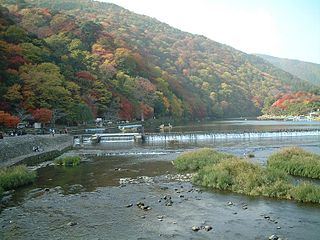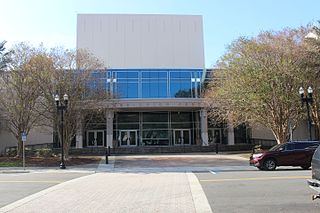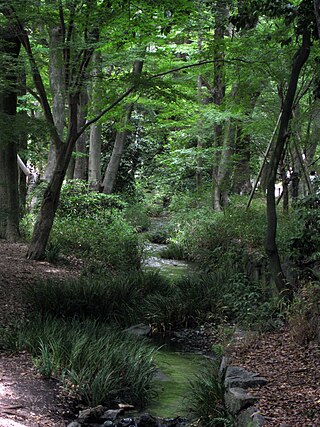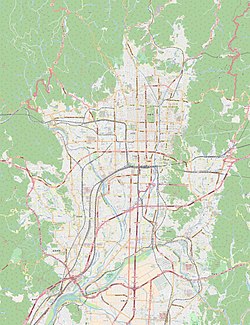
Kyōto Station is a major railway station and transportation hub in Kyōto, Japan. It has Japan's second-largest station building and is one of the country's largest buildings, incorporating a shopping mall, hotel, movie theater, Isetan department store, and several local government facilities under one 15-story roof. It also housed the Kyōto City Air Terminal until August 31, 2002.

Enryaku-ji is a Tendai monastery located on Mount Hiei in Ōtsu, overlooking Kyoto. It was first founded in 788 during the early Heian period (794–1185) by Saichō (767–822), also known as Dengyō Daishi, who introduced the Tendai sect of Mahayana Buddhism to Japan from China. The temple complex has undergone several reconstruction efforts since then, with the most significant taking place in 1642 under Tokugawa Iemitsu. Enryaku-ji is the headquarters of the Tendai sect and one of the most significant monasteries in Japanese history. As such, it is part of the UNESCO World Heritage Site "Historic Monuments of Ancient Kyoto ". The founders of Jōdo-shū, Jōdo Shinshū, Sōtō Zen, and Nichiren Buddhism all spent time at the monastery. Enryaku-ji is also the center for the practice of kaihōgyō.

Arashiyama is a district on the western outskirts of Kyoto, Japan. It also refers to the mountain across the Ōi River, which forms a backdrop to the district. Arashiyama is a nationally designated Historic Site and Place of Scenic Beauty.

Nijō Castle is a flatland castle in Kyoto, Japan. The castle consists of two concentric rings (Kuruwa) of fortifications, the Ninomaru Palace, the ruins of the Honmaru Palace, various support buildings and several gardens. The surface area of the castle is 275,000 square metres, of which 8,000 square metres (86,000 sq ft) is occupied by buildings.

Tō-ji Temple, also known as Kyō-ō-gokoku-ji is a Shingon Buddhist temple in the Minami-ku ward of Kyoto, Japan.

Rohm Semiconductor is a Japanese electronic parts manufacturer based in Kyoto, Japan. Rohm was incorporated as Toyo Electronics Industry Corporation by Kenichiro Sato on September 17, 1958.

Daitoku-ji is a Buddhist temple, one of fourteen autonomous branches of the Rinzai school of Japanese Zen. It is located in Kita-ku, Kyoto, Japan. The "mountain name" (sangō) by which it is known is Ryūhōzan (龍宝山). The Daitoku-ji temple complex today covers more than 23 hectares.

The Kyōto Imperial Palace is the former palace of the Emperor of Japan. Since the Meiji Restoration in 1869, the Emperors have resided at the Tokyo Imperial Palace, while the preservation of the Kyoto Imperial Palace was ordered in 1877. Today, the grounds are open to the public, and the Imperial Household Agency hosts public tours of the buildings several times a day.

The Kyoto Museum for World Peace is part of Ritsumeikan University in Kita-ku, Kyoto, Japan. The Museum is accessible to the public for a 400–600 Yen fee. The displays and materials are mostly in Japanese but there is a 25-page English booklet describing the exhibits. The museum is near Kinkaku-ji and just east of the main Ritsumeikan University campus. In 2004 the museum took over the exhibits of the museum that was part of the Young People's Plaza, designed by famous architect Kenzo Tange.

Ponto-chō (先斗町) is a hanamachi district in Kyoto, Japan, known for its geisha and maiko, and is home to many of the city's okiya and traditional tea houses. Like Gion, Ponto-chō is famous for the preservation of forms of traditional architecture and entertainment.

Shigureden (時雨殿) is a museum in Arashiyama, Kyoto, Japan, centered on the Ogura Hyakunin Isshu anthology of waka poems compiled by Fujiwara no Teika in the 13th century. The museum was founded by former Nintendo president Hiroshi Yamauchi, who invested more than $20 million in the facility. Shigureden's Autumn Shower Palace hall was designed by Nintendo game producer Shigeru Miyamoto.

The Jacksonville Center for the Performing Arts (JCPA) is a performing arts center located in Jacksonville, Florida. Situated along the Riverbank, the venue is known as the First Coast’s "premiere riverfront entertainment facility". Originally opening in 1962, the facility was renovated beginning in 1995 until 1997; with a grand re-opening on February 8, 1997. The center consists of three venues: a theatre; concert hall and recital hall. It is home to the Jacksonville Symphony, Jacksonville Symphony Youth Orchestra, and the FSCJ Artist Series.

Kōzan-ji (高山寺), officially Toganōsan Kōsan-ji (栂尾山高山寺), is a Buddhist temple of the Omuro sect of Shingon Buddhism in Umegahata Toganōchō, Ukyō Ward, Kyoto, Japan. Kōzan-ji is also known as Kōsan-ji and Toganō-dera. The temple was founded by the Shingon scholar and monk Myōe and is renowned for its numerous national treasures and important cultural properties. The Chōjū-jinbutsu-giga, a group of ink paintings from the 12th and 13th centuries, are among the most important treasures of Kōzan-ji. The temple celebrates Biyakkōshin, Zenmyōshin and Kasuga Myōjin, as well as the temple's tutelary Shintō deity. In 1994, it was registered as part of the UNESCO World Heritage Site "Historic Monuments of Ancient Kyoto".
Kyoto University of the Arts, official abbreviated name is "Urigei", "Kyoto Urigei". It is a for-profit private university in Sakyo-ku, Kyoto, Kyoto, Japan. It is a four-year college established in 1991, known as the Kyoto University of Art and Design. The name of the university was changed to Kyoto University of the Arts in 2020.

St. Agnes Cathedral is a Christian church located in Kyoto, Japan, and is the diocesan cathedral of the Diocese of Kyoto, which comprises all the Anglican-Episcopal churches and other facilities in Fukui, Ishikawa, Kyoto, and Toyama Prefectures.

Tadasu no Mori (糺の森), which literally translates to "Forest of Correction" or "Forest of Purification" in English, is located in the Sakyo Ward of Kyoto City, at the site of the Kamomioya Shrine. The forest itself is a sacred grove associated with an important Shinto sanctuary complex known in Japanese as the Kamo-jinja, situated near the banks of the Kamo River just north of where the Takano River joins the Kamo River in northeast Kyoto city, Japan. The term Kamo-jinja in Japanese is a general reference to Shimogamo Shrine and Kamigamo Shrine, the traditionally linked Kamo shrines of Kyoto. The Kamo-jinja serve the function of protecting Kyoto from malign influences.

The Kyoto Art Center is a venue for promoting the arts which is located in the heart of Kyoto, Japan. The center, a three-story reinforced-concrete building, occupies the site of the former Meirin Elementary School . It has a studio, gallery, auditorium, Japanese-style hall, free space, library, an information corner, Japanese-style tea room, the Maeda Coffee Meirin coffee shop, a common room and shops. Kyoto Arts and Culture Foundation manages the center, which aims to support artistic activities, act as a clearinghouse for arts information, plan artist in residence programs and promote artists to the public. In 2008 the north, south and west wings, the gate and wall of the center were registered as one of the Tangible Cultural Properties of Japan.

Sanzen-in (三千院) is a Tendai school monzeki temple in Ōhara, Kyoto, Japan. The Heian period triad of Amida Nyorai flanked by attendants is a National Treasure.

Daihōon-ji (大報恩寺) is a Buddhist temple in Kamigyō-ku, Kyoto, Japan. It is affiliated with Shingon-shū Chizan-ha Buddhism. Its main hall or Senbon Shakadō (千本釈迦堂) is a National Treasure of Japan.





















